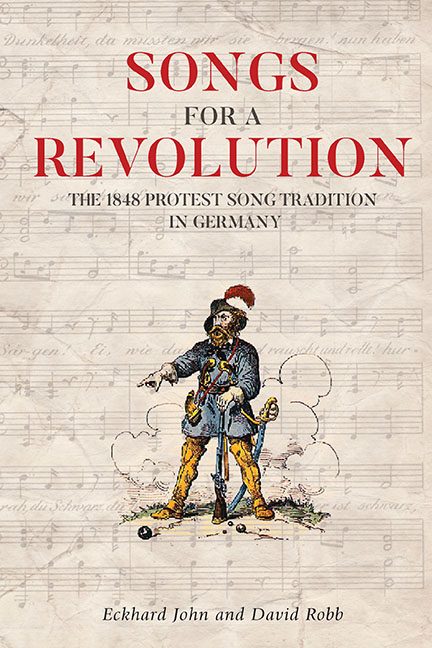Book contents
- Frontmatter
- Contents
- Preface
- Introduction: The Emergence of Political Song 1830–48
- Part I Before 1848: The Vormärz
- Part II 1848–49
- Part III 1848 in Memory
- Conclusion: The Making of Tradition; The Protest Songs of 1848 in the German Folk Revival 303
- Bibliography
- Discography
- Index of Names and Terms
- Index of Song Titles
11 - “Seht, da steht der große Hecker” (“Das Guckkasten-Lied vom großen Hecker”)
Published online by Cambridge University Press: 23 October 2020
- Frontmatter
- Contents
- Preface
- Introduction: The Emergence of Political Song 1830–48
- Part I Before 1848: The Vormärz
- Part II 1848–49
- Part III 1848 in Memory
- Conclusion: The Making of Tradition; The Protest Songs of 1848 in the German Folk Revival 303
- Bibliography
- Discography
- Index of Names and Terms
- Index of Song Titles
Summary
“SEHT, DA STEHT DER GROSSE HECKER” (See the Great Hecker Standing There) is one of the best-known songs about the legendary Baden revolutionary Friedrich Hecker. It was written in 1848 by Karl Christian Gottfried Nadler in the style of a street-minstrel ballad. Unlike other songs dedicated to Hecker, this was originally intended as a parody of the rebel hero and his failed uprising in the spring of 1848. However, in the course of its sustained circulation in the nineteenth century, above all in south Germany, the song underwent a change of function whereby it became part of the Hecker glorification cult. By the early twentieth century, reception of “Das Guckkasten-Lied” had become sporadic. In the 1960s it was rediscovered by Peter Rohland and set to a new melody in the wake of the renewed interest in songs of the 1848 Revolution.
Popularly known as “Das Guckkasten-Lied vom großen Hecker” (The Peep Box Song of the Great Hecker), it was written in early summer 1848, a short time after the defeat of the rebel uprising near Kandern in South Baden on April 20, 1848. Its author, Karl Christian Gottfried Nadler (1809–49), was a Heidelberg lawyer and a poet who wrote in the traditional Palatinate dialect. He rejected the revolutionary developments of the time: as well as his caricature of Friedrich Hecker he also wrote a song lampooning Gustav von Struve, the politician who led the second failed Baden uprising in September 1848. Nadler's political satires were distributed via illustrated broadsides—the popular media of the day. Circulating in this form, the “Guckkastenlied vom großen Hecker” became an overnight success in 1848. An advertisement for the song in the Oberrheinische Zeitung of August 11, 1848 (fig. 11.1) documents this practice of distribution. This ad—viewed alongside the publications of the song in newspapers—enables a relatively exact determining of the date of origin. Parallel to the anonymous illustrated broadside (fig. 11.2), another print appeared attributed to “Johann Schmitt,” a pseudonym of Nadler. In the following months Nadler expanded his 17-verse song by a further five verses.
- Type
- Chapter
- Information
- Songs for a RevolutionThe 1848 Protest Song Tradition in Germany, pp. 160 - 175Publisher: Boydell & BrewerPrint publication year: 2020

